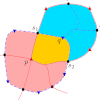Surface network and drainage network: towards a common data structure
DOI:
https://doi.org/10.5311/JOSIS.2023.26.240Keywords:
Morse-Smale complex, surface network, drainage network, digital terrain modelAbstract
The surface network is an application of the Morse-Smale complex to digital terrain models connecting ridges and thalwegs of the terrain in a planar, undirected graph. Although it provides a topological structure embedding critical elements of the terrain, its application to morphological analysis and hydrology remains limited mainly because the drainage network is the most relevant structure for analysis and it cannot be derived from the surface network. The drainage network is a directed, hierarchical graph formed by streams. Ridges of the surface network are not equivalent to drainage divides, which are not contained in the drainage network, and there is no direct association between thalwegs and streams. Therefore, this paper proposes to extend the surface network into a new structure that also embeds the drainage network. This is done by (1) revising the definition of ridges so that they include drainage divides and (2) assigning a flow direction to each thalweg, taking into account spurious depressions to avoid flow interruption. We show that this extended surface network can be used to compute the flow accumulation and different hydrographic features such as drainage basins and the Strahler order. The drainage network extracted from the extended surface network is compared to drainage networks computed with the traditional D8 approach in three case studies. Differences remain minor and are mainly due to the elevation inaccuracy in flat or slightly convex areas. Hence, the extended surface network provides a richer data structure allowing the use of a common topological data structure in both terrain analysis and hydrology.

Downloads
Published
Issue
Section
License
Copyright (c) 2023 Eric Guilbert, Francis Lessard, Naïm Perreault, Sylvain Jutras

This work is licensed under a Creative Commons Attribution 3.0 Unported License.
Articles in JOSIS are licensed under a Creative Commons Attribution 3.0 License.
